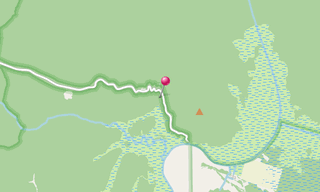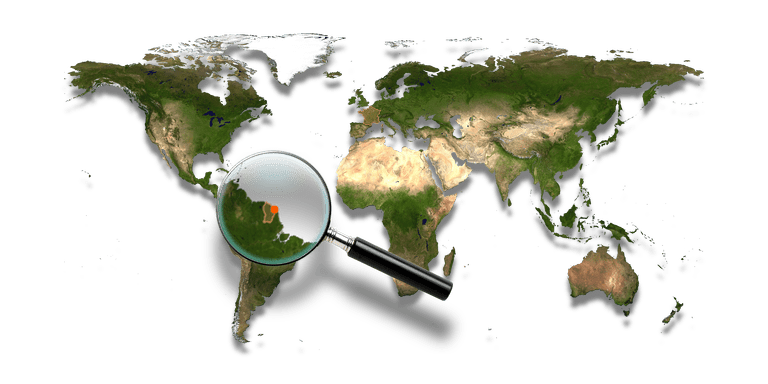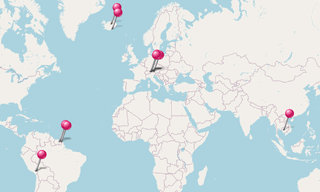The Kaw-Roura Marshland Nature Reserve (Kaw Marshland or Marais de Kaw) is one of six natural reserves created by the French government in French Guiana. This reserve is the second largest nature reserve in France by area (94,700 hectares) after the Nouragues. It was created straddling the communes of Roura and Regina and includes the village of Kaw. By its nature reserve status, fishing, hunting, and the various human activities are strictly regulated by law.
This reserve consists mainly of a marshy area of floating savannah irrigated by the creek Angélique and the Kaw River. It is known for being one of the last refuges of the black caiman. There is alsoan extensive farming, within the marsh, of zebu specie adapted to the “aquatic” life that feeds on wild grass with high forage value.
Other notable species within the reserve are the red alligators, the grey caimans, the spectacled caimans, the Gymnotus (electric eels) and the howler monkeys (baboune) in the surrounding forests. Birds are also very numerous. It includes the black Jacana, the Cocoi heron, several species of egret, etc.
Flora also has bladderwort, a carnivorous plant that catches small organisms at its roots, and some species of water hyacinth plants with beautiful flowers, but very invasive in many tropical countries, except here because it is its region of origin and the ecosystem is adapted.

.hero.landscape.jpg)

.jpg?w=256)
-Chauve-Souris.jpg?w=256)
-Taleve-Favorite.jpg?w=256)
-Jacana-Noir.jpg?w=256)
-Zebu.jpg?w=256)
-Heron-Cocoi.jpg?w=256)
-Jacana-Noir.jpg?w=256)
-Aigrette.jpg?w=256)
-Zebu.jpg?w=256)
.jpg?w=256)
-Taleve-Favorite.jpg?w=256)
.jpg?w=256)
-Moucou-Moucou.jpg?w=256)
-Zebu.jpg?w=256)
-Capybara.jpg?w=256)
-Heron-Cocoi.jpg?w=256)
-Caiman-a-Lunettes.jpg?w=256)
-Cormoran.jpg?w=256)
-Sturnelle-Militaire.jpg?w=256)
-Caiman.jpg?w=256)
-Village-de-Kaw.jpg?w=256)
.jpg?w=256)
-Jacana-Noir-Juvenile.jpg?w=256)
.jpg?w=256)
-Zebu.jpg?w=256)
-Village-de-Kaw.jpg?w=256)
-Zebu.jpg?w=256)
-Zebu.jpg?w=256)
-Aigrette.jpg?w=256)
.jpg?w=256)
-Jacana-Noir.jpg?w=256)
-Caiman-a-Lunettes.jpg?w=256)
-Martin-Pecheur.jpg?w=256)
-Village-de-Kaw.jpg?w=256)
.jpg?w=256)
.jpg?w=256)
.jpg?w=256)
-Zebu.jpg?w=256)
-Caiman-a-Lunettes.jpg?w=256)
.jpg?w=256)
-Moucherolle-a-Tete-Blanche.jpg?w=256)
.jpg?w=256)
.jpg?w=256)
-Aigrette.jpg?w=256)
-Aigrette.jpg?w=256)
.jpg?w=256)
-Heron-Cocoi.jpg?w=256)
-Caiman.jpg?w=256)
.hero.jpg?w=320)

-Obersee.hero.jpg?w=320)

.hero.jpg?w=320)

.hero.jpg?w=320)

.hero.jpg?w=320)

-Caiman-a-Lunettes.jpg?w=256)
-Taleve-Favorite.jpg?w=256)
-Aigrette.jpg?w=256)
-Village-de-Kaw.jpg?w=256)
-Urubu-a-Tete-Rouge.jpg?w=256)
-Aigrette.jpg?w=256)
-Heron-Cocoi.jpg?w=256)
-Cormoran.jpg?w=256)
-Heron-Cocoi.jpg?w=256)
-Jacana-Noir.jpg?w=256)
-Zebu.jpg?w=256)
-Moucherolle-a-Tete-Blanche.jpg?w=256)
-Village-de-Kaw.jpg?w=256)
-Donacobe-a-Miroir.jpg?w=256)
-Heron-Cocoi.jpg?w=256)
-Zebu.jpg?w=256)
.jpg?w=256)
.jpg?w=256)
-Village-de-Kaw.jpg?w=256)
-Moucherolle-a-Tete-Blanche.jpg?w=256)
-Martin-Pecheur.jpg?w=256)
.jpg?w=256)
.jpg?w=256)
-Caiman.jpg?w=256)
.jpg?w=256)
-Caiman-a-Lunettes.jpg?w=256)
-Jacana-Noir.jpg?w=256)
-Balbuzard-Pecheur.jpg?w=256)
-Martin-Pecheur.jpg?w=256)
-Chauve-Souris.jpg?w=256)
-Heron-Cocoi.jpg?w=256)
-Martin-Pecheur.jpg?w=256)